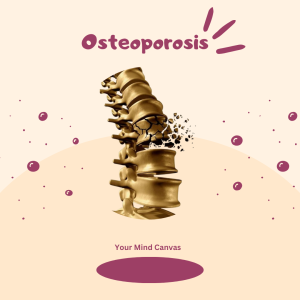
Osteoporotic bone
Consider a condition that weakens your bones subtly, putting you at risk for fracturing without any outward signs. Known as a “silent disease,” osteoporosis affects millions of people around the world, yet many people are ignorant of it before it’s too late. We’ll discuss osteoporosis’s causes, symptoms, preventative techniques, and available treatments in this blog, empowering you to take charge of how well your bones are doing. Don’t wait for a fracture to alert you to this issue; continue reading to find out how to safeguard your bones now!
What Is Osteoporosis?
Osteoporosis, a prevalent condition, is systemic deterioration of bone mass and microarchitecture that leads to fractures due to fragility. As the population ages, osteoporosis—especially postmenopausal osteoporosis—will have a greater medical and social impact. The fractures that develop provide a serious health risk. The most frequent fractures linked to osteoporosis are those of the hip, vertebra, and wrist. Worldwide, there are notable variations in the prevalence and consequences of osteoporosis among various populations. White people are far more likely than non-white people to have hip fractures. Furthermore, within groups of a certain race and gender, there is significant variance.
Primary Causes of Osteoporosis
The following are some of the variables that lead to osteoporosis:
- Age: As we become older, our bone density naturally declines.
- Gender: Women are particularly vulnerable following menopause.
- Hormonal Imbalances: The risk may rise if there are lower levels of estrogen and testosterone.
- Lifestyle factors: Include smoking, excessive alcohol use, poor diet, and a lack of physical activity.
- Family History: Osteoporosis can be more likely to develop if there is a family history of the disorder.
Secondary Causes of Osteoporosis:
- Endocrine Disorders:
Hormone abnormalities that impact bone formation, such as hypogonadism (low testosterone), diabetes, hyperthyroidism, and Cushing’s syndrome.
Problems with
- Starvation:
Inadequate nutrient absorption brought on by illnesses such as gastric bypass surgery, IBS, anorexia nervosa, or celiac disease. A major contributing cause is a lack of vitamin D.
- Marrow Conditions:
Bone marrow health is impacted by diseases such as multiple myeloma, persistent alcohol use, and lymphoma.
- Disorders of Collagen:
abnormal collagen synthesis in diseases like Marfan syndrome and osteogenesis imperfecta.
- Autoimmune Conditions:
Decreased bone formation or a lack of vitamin D in conditions such as multiple sclerosis, ankylosing spondylitis, and rheumatoid arthritis.
- Renal Conditions:
Problems relating to the kidneys, such as idiopathic hypercalciuria (excess calcium in urine) or chronic renal disease.
- Drugs Raising the Risk:
Prolonged use of some medications, such as;
- Glucocorticoids (the most prevalent reason).
- Excessive replenishment of thyroid hormones.
- CNS drugs (anticonvulsants, antidepressants).
- Immune suppressants, such as antiretroviral medication and calcineurin inhibitors.
- For gastrointestinal problems, proton pump inhibitors.
Symptoms of these silent disease:
Until a fracture happens, osteoporosis frequently shows no symptoms. Typical indicators include:
- Back discomfort brought on by a vertebral fracture or collapse
- A gradual decline in height
- Stooped posture
- Fractures resulting from minor trauma
- Problems with mobility
- Sarcopenia
Prevention and Modifications to Lifestyle:
Although osteoporosis is treatable, prevention is always the best course of action. The following strategies can help to fortify bones and lower the risk of osteoporosis:
- Diet: Make sure you eat a diet high in calcium and enough vitamin D. Good sources include foods like leafy greens, dairy products, and fortified cereals.
- Exercise: Walking, jogging, and strength training are examples of weight-bearing activities that can support bone density maintenance.
- Limit alcohol intake and abstain from smoking: It is well known that smoking and binge drinking accelerate bone loss.
- Bone Density Testing: By identifying osteoporosis early, routine bone density testing can improve management and treatment.
Osteoporosis Treatment Options:
In order to assist manage osteoporosis, there are a number of therapy options available:
- Drugs: Bisphosphonates, hormone therapy, and other drugs can help prevent fractures and delay bone loss.
- Supplements: Including calcium and vitamin D can assist in making sure the body has the nutrients to support healthy bones.
- Working with a physiotherapist: It can help you become stronger and more balanced, which lowers your risk of fractures and falls.
Don’t wait for osteoporosis symptoms to show up. Take action now to protect your bones! There has never been a better moment to put your bone health first, whether that means scheduling a bone density test, increasing your exercise, or making dietary changes. Help raise awareness about osteoporosis prevention by sharing this article with your loved ones. Subscribe to our blog or book an appointment for tailored guidance and more pointers on leading a healthy lifestyle. Together, let’s maintain strong bones for many years to come!
